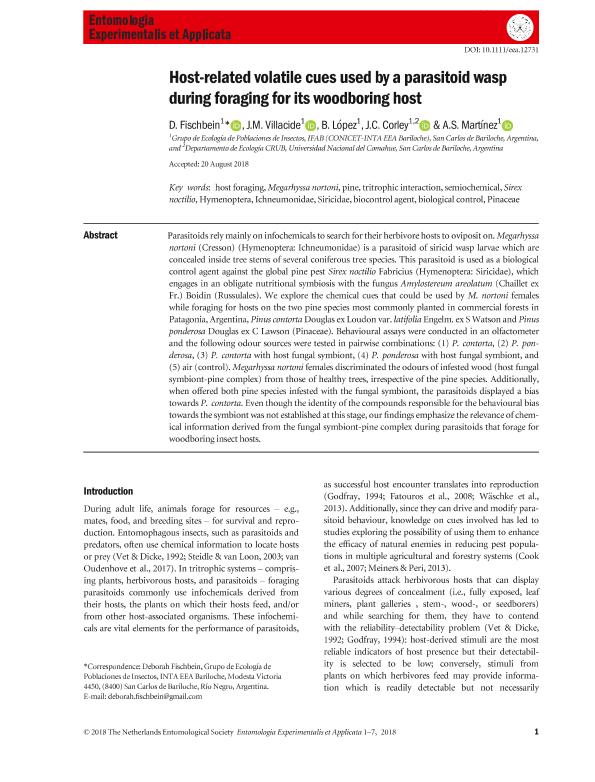Artículo
Host-related volatile cues used by a parasitoid wasp during foraging for its woodboring host
Fischbein, Deborah ; Villacide, José María; Lopéz, B.; Corley, Juan Carlos
; Villacide, José María; Lopéz, B.; Corley, Juan Carlos ; Martinez Von Ellrichshausen, Andres Santiago
; Martinez Von Ellrichshausen, Andres Santiago
 ; Villacide, José María; Lopéz, B.; Corley, Juan Carlos
; Villacide, José María; Lopéz, B.; Corley, Juan Carlos ; Martinez Von Ellrichshausen, Andres Santiago
; Martinez Von Ellrichshausen, Andres Santiago
Fecha de publicación:
20/10/2018
Editorial:
Wiley Blackwell Publishing, Inc
Revista:
Entomologia Experimentalis et Applicata
ISSN:
0013-8703
Idioma:
Inglés
Tipo de recurso:
Artículo publicado
Clasificación temática:
Resumen
Parasitoids relymainly on infochemicals to search for their herbivore hosts to oviposit on. Megarhyssanortoni (Cresson) (Hymenoptera: Ichneumonidae) is a parasitoid of siricid wasp larvae which areconcealed inside tree stems of several coniferous tree species. This parasitoid is used as a biologicalcontrol agent against the global pine pest Sirex noctilio Fabricius (Hymenoptera: Siricidae), whichengages in an obligate nutritional symbiosis with the fungus Amylostereum areolatum (Chaillet exFr.) Boidin (Russulales). We explore the chemical cues that could be used by M. nortoni femaleswhile foraging for hosts on the two pine species most commonly planted in commercial forests inPatagonia, Argentina, Pinus contorta Douglas ex Loudon var. latifolia Engelm. ex SWatson and Pinusponderosa Douglas ex C Lawson (Pinaceae). Behavioural assays were conducted in an olfactometerand the following odour sources were tested in pairwise combinations: (1) P. contorta, (2) P. ponderosa,(3) P. contorta with host fungal symbiont, (4) P. ponderosa with host fungal symbiont, and(5) air (control). Megarhyssa nortoni females discriminated the odours of infested wood (host fungalsymbiont-pine complex) from those of healthy trees, irrespective of the pine species. Additionally,when offered both pine species infested with the fungal symbiont, the parasitoids displayed a biastowards P. contorta. Even though the identity of the compounds responsible for the behavioural biastowards the symbiont was not established at this stage, our findings emphasize the relevance of chemicalinformation derived from the fungal symbiont-pine complex during parasitoids that forage forwoodboring insect hosts.
Archivos asociados
Licencia
Identificadores
Colecciones
Articulos(CCT - PATAGONIA NORTE)
Articulos de CTRO.CIENTIFICO TECNOL.CONICET - PATAGONIA NORTE
Articulos de CTRO.CIENTIFICO TECNOL.CONICET - PATAGONIA NORTE
Citación
Fischbein, Deborah; Villacide, José María; Lopéz, B.; Corley, Juan Carlos; Martinez Von Ellrichshausen, Andres Santiago; Host-related volatile cues used by a parasitoid wasp during foraging for its woodboring host; Wiley Blackwell Publishing, Inc; Entomologia Experimentalis et Applicata; 166; 11; 20-10-2018; 907-913
Compartir
Altmétricas



